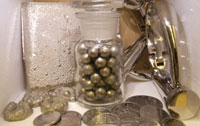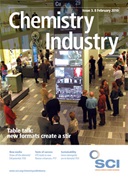Modern interpretations of the traditional periodic table are gaining in popularity and reveal a lot more about the elements than their weight and atomic number, reports Cath O'Driscoll
Martyn Poliakoff and Pete Licence aren’t much used to dealing with fan mail. But the Nottingham University chemists and green solvent experts are rapidly having to readjust to their new found fame as the stars of the now widely acclaimed Periodic Table of Videos (PTOV, http://www.periodicvideos.com). ‘I am six years old. I really like your videos. I would like to be a chemist in Nottingham like you when I grow up,’ one enthusiastic youngster recently emailed Poliakoff after seeing him in action by clicking on the element links on the site and watching him enthuse about each one’s properties – backed up by footage of laboratory colleagues carrying out often explosive and highly entertaining experiments.
The world’s most beautiful periodic tables

The PTOV’s appeal ranges from young children to Nobel laureates, Poliakoff says. As well as being fun, it also provides information that cannot be easily found elsewhere. ‘I’m amazed at how you can make a boring element like Md (Mendelevium) interesting,’ wrote another correspondent. ‘If I looked it up on Wikipedia I could probably find its isotopes, its electronic structure, maybe its physical properties. But I’d never have known that you can get vodka labelled as C2H5OH+H2O, or that the periodic table’s called the mendeleev table in Russia etc.’
While the traditional flat periodic table that has graced school classrooms for decades is still going strong, however, modern variations such as PTOV are fast gaining in popularity. Spurred on by the development of technology, including the availability of new media, these new tables are inspiring a growing fanbase of interested science enthusiasts and budding chemists interested in finding out more than the element’s symbol and atomic weight.
At RGB Research, Bafta award winning former TV producer Max Whitby and collaborators have created what he claims are the world’s most beautiful periodic tables – made by using physical samples of the actual elements (www.periodictable.com). An alarming number of elements can be found on eBay, remarks Whitby’s colleague Fiona Barclay; however, others are sourced by lateral thinking - a supertanker’s sacrificial anode is a good source of magnesium, for example. One of the company’s first ‘installations’ was a 10 foot wide by 7 foot tall element collection created for DePauw University in Indiana, US, in 2004 and crafted from cherry wood by the group’s US partner Theodore Gray, author of the popular Mad science books. Samples of 92 natural elements are presented in the display in separate cubes, each illuminated with super-bright LED lights. The cabinet also incorporates a touch-screen that calls up photos, information and video footage about each element via a hidden computer.
However, the real skill in creating these element collections, Whitby says, is to present them as attractively as possible, with each element arranged in a tableau along with related artefacts, such as seashells and bone for calcium, for example, or a bunch of coloured telephone cables in the copper exhibit. ‘Our art is to find the true soul of the element and present it in a form that shows its special characteristics,’ Whitby enthuses. ‘What Theo and I are trying to do is to make people enjoy and appreciate the elements aesthetically. We like to think that we create works of art as well as science.’
Element Collections
While most of the elements occur naturally as ‘dreary grey powders’, RGB possesses an arc furnace that allows the team to melt samples of even the highest melting point element tungsten at 3400oC and recast them in more interesting and lustrous solid metal forms. Another prized bit of kit is a three-phase donkey saw for rugged cutting.
Creating these real ‘Element Collections’ is primarily an exercise in health and safety, Whitby says, adding that had he known all the problems at the outset he would never have embarked on the project. About half of the elements in the table carry ‘some degree of risk’ and the most hazardous are typically stored under argon or sealed in double and even triple ampoules. And while it is not possible to include the transuranic elements in the collections because of their short half lives, several radioactive ones – including thorium and uranium, safely packaged – are included.
One of the rarest and most valuable elements in the table, meanwhile, is rhodium, Whitby notes, adding that when he first bought it to create some of the original tables the element cost $500/troy ounce (31.1g) – a price that subsequently shot up to $10, 000/ounce!
Alongside some of its larger installations, RGB also produces smaller collections and individual element blocks, mainly sold to schools, libraries and universities. To date, the firm has sold around 250 element collections, including a display recently installed at the HQ of Dow Chemical in Midland, Michigan, US. Another recent venture, meanwhile, is a 20 foot tall multimedia extravaganza completed in 2008 for the Chemical Heritage Foundation in Philadelphia, Pennsylvania, US. While this spectacular video column does not contain actual elements, it does feature a touchsensitive computational display of light, pictures and sound – conjuring up a cacophony of animated chemical reactions that creates an experience that is hard to forget.
‘Our aim is to overwhelm the audience by creating a fountain of many reactions all together,’ Whitby says. Many of the video experiments featured – including demos of liquid nitrogen being poured onto a lake, subtitled ‘no fish were harmed during the making of this film’, and an explosion involving adding a 0.5kg block of sodium to water - were conveniently performed at Gray’s private farm in the Prairies, Whitby says. The whole project took four years to complete and includes half a million frames, a feat that would not have been possible without the complex Mathematica software devised by Gray and colleagues at his company Wolfram Research.
The UK Royal Society of Chemistry’s Visual Elements Periodic Table
(http://www.rsc.org/chemsoc/visualelements/index.htm) is another attempt to combine art and science to create new representations of the elements, in this case by drawing on the symbolism that each evokes. The symbol for rhodium, for example, is a rose – harking back to the derivation of the element name from the Greek rhodon, while iridium is represented by a dragonfly’s iridescent wings. ‘It offers everything that a traditional Table does plus it reaches across the science/art boundary,’ says the RSC’s director of communications Neville Reed. ‘The images are a thing of beauty and can be admired in their own right. We know that the “public” like the art aspect and can be drawn into the science as a result.’
The Table’s popularity can be gauged by its impact on Google, where it has consistently been in the top 10 for over 10 years, Reed says – ‘plus time at number one’ He adds that it has spun off sales of wallcharts, top trumps games, data sheets and a touring exhibition. ‘It has been the most popular non-publishing web feature that the RSC has ever had. It has had millions of users,’ Reed says, adding that a Chinese version is set to be launched later this year while there are also plans to update the Table by integrating more data and other features via ChemSpider and other RSC material.
More challenging scientifically, perhaps, are novel three-dimensional and other table designs that break with the traditional flat renditions. The Alexander Arrangement of the Elements (AAE), for example, orders the elements ‘contiguously and continuously according to their atomic numbers’, and so claims to ‘eliminate the confusion and apparent inconsistencies’ in the traditional flat table representations, according to its inventor and former museum exhibit designer Roy Alexander. ‘3D connects all the elements in order instead of the dozen or so breaks in sequence inherent in the flat table, which also disconnects two rows of elements, the rare earths, from the main table altogether,’ Alexander says, adding that the arrangement also resolves the contentious issue of where to place hydrogen in the Table.
AAE designs are now used in several schools, Alexander says. ‘In my opinion, the interactive, tactile, construction oriented qualities of the AAE clearly appeal to boys for whom the flat periodic table is an anathema,’ he says. As with all threedimensional objects, he points out that the AAE can be viewed from several different positions and must be revolved to see the whole picture. ‘While this is happening…the definition of the various parts of the element arrangements are made far more clearly than flat charts can, and the tactile sense of the observer reinforces the information.’
Public enthusiasm for new periodic table designs, meanwhile, shows no signs of abating. At the end of 2009, for example, Poliakoff featured on the US news station CBS – even receiving an email after the broadcast from as far away as Ethiopia. And now that the element videos are on-going, he says there is EPSRC funding to extend the PTOV concept to molecules and other substances of general interest; many people have asked for such videos including the UK government children’s secretary - and Nottingham alumnus - Ed Balls. The first videos covering simple molecules will be uploaded early in 2010, with ‘specials’ when a particular compound becomes newsworthy. And with around 50m man-made and naturally occurring molecules available to choose from, the PTOV team may not have too much time to answer fan mail.





